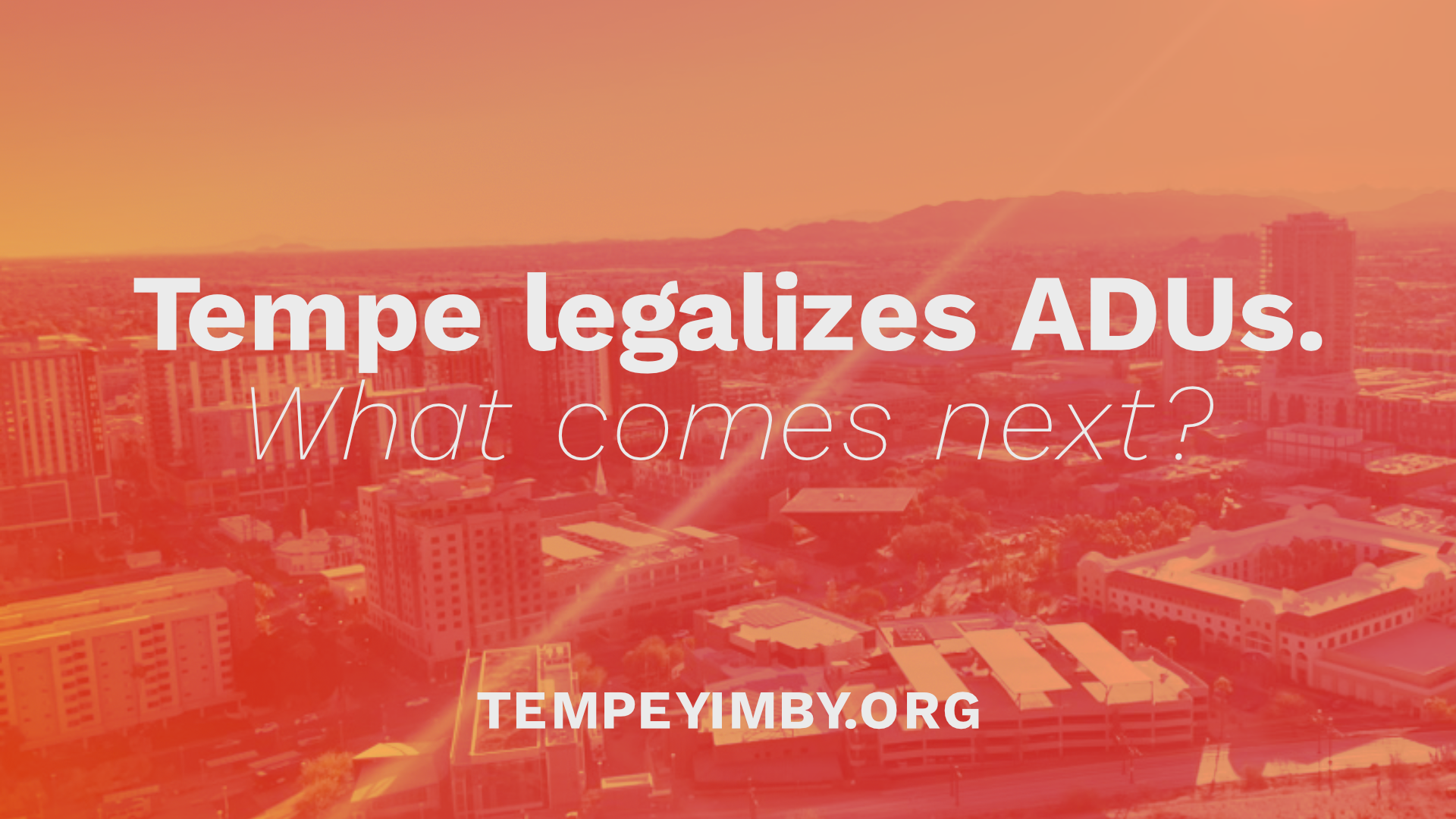In November, Tempe City Council approved an ordinance allowing Accessory Dwelling Units (ADUs) across single family residential areas citywide.
The ordinance was passed to comply with HB 2720, a new statewide law which seeks to ease Arizona’s housing shortage by requiring larger cities to allow backyard tiny homes in single-family residential areas.
In addition to allowing ADUs, the bill sets guardrails to prevent localities from enacting costly restrictions that make them impractical to build. Additionally, a bonus ADU can be built on large lots, provided it will be rented to households making 80% of Area Median Income.
The passage of this ordinance is a success for the pro-housing movement in Tempe, but it also paints a clear picture of how cities have been slow and ineffective at responding to the housing crisis.
ADUs in Tempe: A Brief History
In 2019, Tempe passed an ADU ordinance which was perfectly designed if the goal was to produce almost no new homes. They were allowed on a very small number of properties—just single-family properties zoned for multifamily housing. This ordinance resulted in just a handful of ADUs being permitted between 2019 and 2023.

Simultaneously, rents in Tempe and across the state skyrocketed as population growth outpaced the number of homes available, causing more people to compete for a dwindling supply of housing.
Too Slow, Too Furious
Tempe began the process of updating its ADU ordinance in late 2023. At the start of the process, we warned that the city was moving too slowly on an easy housing reform. Inadvertently, the city was making the case that statewide reforms were necessary to begin seriously tackling the housing crisis.
This proved correct. Tempe moved slowly on ADU legalization, bogging the process down in input sessions. These sessions generated angry and unconstructive comments. Many public comments were filled with resentment, of fear of change, or general abuse hurled at city staff. This is standard procedure for these types of meetings, and predictably only the negative voices were heard.
As a result, the proposal was bogged down in ill-conceived rules on parking and owner-occupancy. These rules went against best practices and would have made the reforms much less effective at getting housing built.
Despite the head start, state legislators quickly overtook the city, passing a law requiring large localities to adopt a far better ADU ordinance than the city was considering enacting. Importantly, it disallowed some of the worst elements of Tempe’s proposed ordinance, such as requiring costly and unnecessary parking mandates.
The Oracle of Tempe
This is not brought up to pick on our beloved city or to tout the predictive analysis readers expect from Tempe YIMBY. Prophetic abilities were not required to see where this was headed, as an all too familiar cycle unfolded.
First, reforms are proposed to allow badly needed housing to be built. Then, a select few homeowners who are often older, wealthier, and better connected than most residents mobilize to dominate the feedback process. Their fears are often unfounded by the evidence. Attempting to allay these fears, city officials back down or make changes. These changes often attempt to solve nonexistent problems. Finally, watered-down policy fails to solve a very real problem (a housing crisis) or to even satisfy opponents.
This is not a cycle exclusive to Tempe, but it is one that must be broken if the city wants to claw its way out of a housing shortage.
Break the cycle
With HB 2721, Tempe has until the end of 2025 to expand where missing middle housing is allowed in the city. Specifically, it must allow duplexes, triplexes, fourplexes, and townhomes to built on all single-family lots a mile from its “central business district.” This provides an opportunity for the city to go beyond what state law requires and show that it is committed to aggressively tackling the housing shortage.
Depending on exactly how “central business district” ends up being defined, much of the land within a mile of it will be ASU campus, multifamily, or otherwise non-residential. This means a law intended to boost housing supply could end up being less effective in one of the cities best positioned to benefit.
Here’s a modest proposal: Tempe should allow missing middle homes on residential lots citywide. It is simply good on the merits. More homes are badly needed to chip away at our housing shortage.
Tempe is being presented with another chance to seriously lead on housing and get ahead of criticism that cities have done far too little, far too late. The single best tool cities have to combat the housing crisis is allowing more housing to be built. This is a power all cities in Arizona currently have. They can go beyond what state law requires.
Hopefully the Mayor and Council will crack open the toolbox and show the rest of the state how it’s done.


Leave a Reply